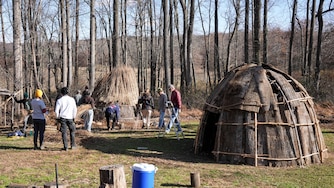Early Thursday morning, the water in the Lancaster Street Canal looked like red wine to Baltimore Fire Chief James Wallace. By late afternoon, it had largely returned to a murky brown, with occasional rainbow shimmers on the surface.
Officials said at a news briefing Thursday that roughly 18,000 gallons of water have been removed from Baltimore’s harbor, though it remains unclear how much of the 2,000 gallons of red-dyed diesel fuel that spilled a day earlier was included.
More than 100 personnel from Maryland environmental agencies, Baltimore’s emergency response team and the U.S. Coast Guard mobilized Wednesday to respond to the spill near the Harbor East neighborhood. It originated at a Johns Hopkins Hospital facility more than a mile to the north. Fuel escaped into storm drains, which empty into the harbor.
“We are exactly where we need to be at this particular time,” Mayor Brandon Scott said Thursday, as vacuum trucks worked along the South Central Avenue Bridge behind him.
Scott and Wallace said agencies planned to scale back the cleanup Thursday evening to give responders time to rest before resuming work Friday. Central Avenue between Lancaster and Point streets remained closed to vehicle and foot traffic.
Fire Department crews have been flushing stormwater tunnels to push the diesel fuel into the harbor, where responders have largely contained the spill in a series of booms.
Crews have used five vacuum trucks and two boats to suck contaminants from the harbor. Gov. Wes Moore reported Thursday that responders had removed hundreds of gallons of diesel.

While city and state officials reported substantial progress, officials don’t know how much of the diesel fuel is trapped in underground tunnels. Wallace said it could take a significant rain to completely clear the system.
The spill originated at a Hopkins Hospital facility on Fayette Street, where two diesel tanks were overfilled during a routine delivery by a third-party company, the hospital said in a statement Wednesday night. The fuel there is used to power backup generators for patient-care facilities.
City and state officials did not provide more detail Thursday on how the spill began, and Hopkins spokespeople did not elaborate on the cause.
In a statement late Thursday, the hospital system said it is working closely with government authorities and focused on the health of the community and environmental cleanup.
“This is our home, and we are fully committed to funding the cleanup and remediation efforts in the Inner Harbor, including any impacts to local wildlife,” Kim Hoppe, vice president of public relations for Johns Hopkins Medicine. “While we are concentrating on the cleanup effort, we are also closely reviewing the situation to understand what happened.”
By the afternoon, a diesel smell lingered over the area, including the Harbor East Marina at the edge of the canal.
Environmental officials said the spill, while unpleasant, has not caused air-quality issues.
Birds and turtles have also been affected, including at a floating habitat in the Lancaster Street Canal known as “turtle island.”
Maryland Natural Resources Secretary Josh Kurtz said agency officials worked through the night to rescue animals from the contaminated area. Twenty-five geese and three turtles were in the hands of the Delaware-based Tri-State Bird Rescue, Kurtz said, and it was working to clean and treat the animals before releasing them back into their native habitats.
The response is focused on “heavy pockets” of diesel, said Geoffrey Donahue, director of emergency preparedness and response with the Maryland Department of the Environment. Other thin sheens of oil are considered unrecoverable and will evaporate on their own, Donahue said.
Adam Lindquist, vice president of the Waterfront Partnership, listened to officials’ updates Thursday afternoon and praised the swiftness of the emergency response.

The Waterfront Partnership is organizing a second Harbor swim this month, an event meant to showcase the safety of water activities along Baltimore’s waterfront. Lindquist said he’s “cautiously optimistic” the spill will not affect the event.
Earlier in the day, the nonprofit Blue Water Baltimore sent its own boat to investigate the spill site and monitor environmental harms.
Alice Volpitta, Baltimore Harbor waterkeeper for Blue Water, said the team didn’t find any fish kills but did observe a thin sheen of diesel beyond the containment boom.
The public deserves answers about how this spill happened, Volpitta said. State environmental regulators should publicize the results of their investigation and any enforcement steps they take.
Was it negligence? A mechanical failure? Volpitta asked. “Some follow-up from agencies I think is imperative, because we don’t always get that.”





Comments
Welcome to The Banner's subscriber-only commenting community. Please review our community guidelines.